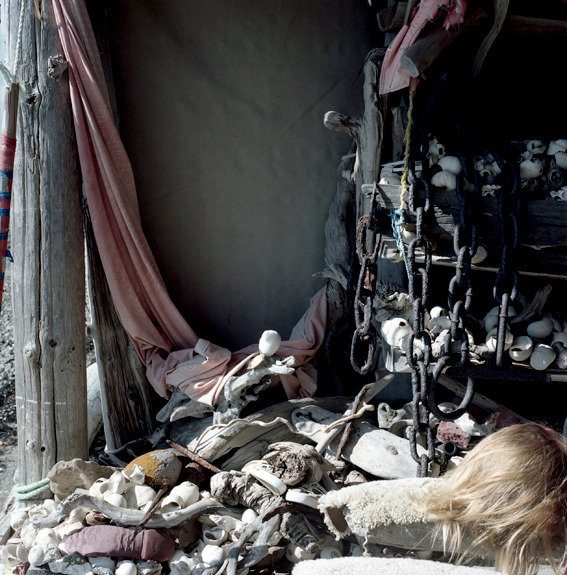Two exhibitions
dal 10/4/2013 al 4/5/2013
Segnalato da
10/4/2013
Two exhibitions
Kunstlerhaus Bethanien, Berlin
Tarantel 1: five artistic positions that the exhibition is setting into an international context for the very first time; photographs by Winfried Bullinger, Steffi Klenz, Melissa Moore, Rachel Rom, Kerstin Schroder. Roey Heifetz' most recent work consists of drawings of oversized figures that seem to float in front of the white paper background.

Tarantel 1
Winfried Bullinger, Steffi Klenz, Melissa Moore, Rachel Rom, Kerstin Schröder
A tarantula is an arachnid from the family of wolf spiders. Signs of poisoning and St. Vitus’ dance are generally attributed to the bite of the tarantula.
TARANTEL 1 seeks its quarry among a curious public, with five artistic positions that Künstlerhaus Bethanien is setting into an international context for the very first time: their pictorial reality, remarkably promising and dangerously enticing, emphasizes a feminine side. Visitors must decide for themselves whether viewing these images will have detrimental effects on them.
Winfried Bullinger’s photographs place an emphasis on depicting the condition humaine. In the Künstlerhaus, Bullinger is showing three portraits of women from the series Nomads, women belonging to peoples that still live in largely autonomous societies between the Blue Nile and Lake Turkana in Africa. There, too, the global search for resources, failure of the expected rains, and political and armed conflicts are leading to far-reaching social changes. Bullinger’s photographs, which are taken in black and white using a large-format analogue camera and in natural daylight, are something between documentation and staging. / www.wbullinger.com
Steffi Klenz’ work unfolds in urban places and buildings but it is not architectural photography but instead engages with the space in question as a location for transition and transformation. For the Surrealist poet Louis Aragon, buildings were “thresholds to a kingdom of the marvellous” and Klenz’ photographic work also presents the house as more than a “machine for living” as identified by the modernist Le Corbusier: a theatre of the domestic that represents the interior environment as a mysterious space of a fragmented kind. / www.steffiklenz.co.uk
Melissa Moore presents Land Ends, a selection of photographs taken on the Hornby Island, Canada, where she retired for several times over 13 years. Her work takes its cue from the architecture of the place, largely inspired by Shelter, the book published for the first time in 1973 that gave birth to the current revolution of Green Building. / www.melissamoore.info
Rachel Rom is using her portraits (previously exhibited as such) as raw material, to create four installations: echo, vector, remanence and nucleus to question the relationship between the author and his work and the definition of art. She is using the concept of distance to demonstrate the futility of the material work, re-photographing portraits to give them a remanence in time. Her subjects move forward in time, but do not age. As if renovated. / www.rachelrom.com
Kerstin Schröder’s work Study after Grünewald shows a man’s head distorted into a scream; it is the translation of a drawing by Matthias Grünewald into the third dimension. In this sculpture the motif of pain that is so identificatory and thus comforting in Grünewald’s work becomes the desired result of an obsessive female fantasy of revenge – an ironic comment on the immanence of a sexist reality. Virago I is a bronze cast of an old leather horse-collar. With its undeniable likeness to the female sex, it extends the issue of power relations between human being and beast to include man and woman. / www.kerstin-schroeder.de
With generous support from the Governing Mayor of Berlin, Senate Office – Cultural Affairs
-------
Roey Heifetz
The Teacher's Nap
Roey Heifetz’ most recent work consists of drawings of oversized figures that seem to float in front of the white paper background. The artist often provides them with generic titles such as “The Secretary”, “The Librarian” or “The Teacher” and subjects them to an intense process of deconstruction. The act of drawing is important to him rather than the story of the characters, which always remains untold. The artist enters into an intense dialogue with his works, which the enigmatic fascination to his figures in the field of conflict between figuration and abstraction, uniformity and precise details.
The key work of his current exhibition is The Teacher’s Nap (2011), Heifetz’ first horizontally oriented drawing. It shows a long, stretched-out figure – the teacher – lying down at a moment of relaxation and thus loss of control. Heifetz’ work consciously creates ambivalence and leaves the viewer uncertain whether the recumbent woman is asleep or already showing the first signs of physical deterioration in death. He creates a floating state between alertness and sleep, life and death – and so hits on that cathartic moment when the process of losing control and separation from reality begins. On the upper floor of the gallery space the visitor is then truly overwhelmed by a remarkable installation comprising oversized drawings arranged as a kind of walk-in ‘cabinet’. The figures seem simultaneously strong and vulnerable, radiating as much glamour as decadence: here, they enter into an intense relation with the viewer, so involving him/her in the associative interplay of the characters that Heifetz represents.
Image: Melissa Moore, Flotsam, 2012. Copyright: Melissa Moore / Courtesy of Metronom, Modena
Press contact:
Christina Sickert 030 616903 - 15 sickert@bethanien.de
Opening 11.04.2013 7 pm
Künstlerhaus Bethanien
Kottbusser Straße 10 10999 Berlin
Tue – Sun: 2pm – 7pm
Admission free



